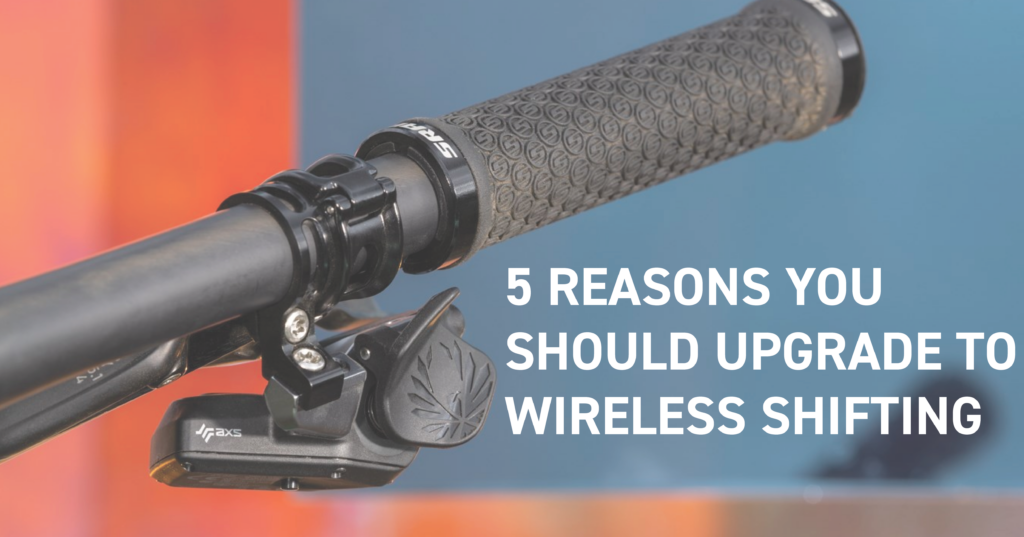5 Reasons You Should Upgrade to Wireless Shifting for Your MTB
5 Reasons You Should Upgrade to Wireless Shifting
Switching to wireless mountain bike shifting can offer several advantages for riders. Here are five reasons why you might consider making the upgrade:
1. Precision and Reliability:
Wireless shifting systems use electronic signals to communicate between the shifters and derailleurs. This eliminates the delays and cable stretch associated with traditional cable-based systems, ensuring that gear changes happen almost instantaneously. This is crucial for precise shifts, especially during technical mountain biking where split-second gear changes can make a difference. With no cables to stretch or degrade over time, you can expect consistent and accurate shifts. Many wireless systems also allow for micro-adjustments, meaning you can fine-tune the position of the derailleur with great accuracy. This level of customization can help you achieve the perfect gear setup for your riding style and terrain, further enhancing precision.
2. Reduced Maintenance:
Traditional cable-based shifting systems require regular maintenance, including cable replacements and adjustments. Wireless systems eliminate the need for these tasks, saving you time and money on upkeep. It reduces the chances of misalignment or cable-related issues that can affect precision in traditional setups. This can be particularly beneficial for riders who frequently expose their bikes to harsh conditions. Many wireless shifting systems are designed to be weather-resistant, meaning they can perform well even in wet and muddy conditions. Traditional cables can become clogged with dirt, affecting shifting performance and requiring frequent cleaning and maintenance.
3. Simplified Installation:
One of the most significant advantages of wireless systems is the elimination of the need to route cables through the frame. Internal cable routing, which is common on modern mountain bikes, can be a complex and time-consuming process. Wireless shifting simplifies the setup process and can make it more accessible for riders who want to perform their own maintenance and upgrades. Wireless systems also have fewer components to install than their cable-based counterparts. In a traditional setup, you need to install shift cables, cable housing, and associated cable guides, while wireless systems typically only require the installation of the shifters and derailleurs. Wireless systems are designed to be compatible with a range of frame designs and sizes. This means you don't need to worry about finding the right length of shift cable or housing, which can be a concern with traditional cable-based setups.
4. Clean Aesthetics:
The most noticeable improvement in aesthetics is the absence of visible shifter cables. In traditional cable-based systems, shifter cables run along the frame, often cluttering the bike's appearance. With wireless shifting, these unsightly cables are eliminated, providing a cleaner and more modern look to your bike. The cockpit area of your bike, where the handlebars, brake levers, and shifters are located, benefits from a cleaner appearance without shifter cables. This streamlined cockpit enhances visibility, reduces distractions, and can contribute to a more enjoyable riding experience. This not only enhances the aesthetics of your bike but can also reduce the chances of cable clutter interfering with other components or snagging on obstacles during rides.
5. Customization Options:
Many wireless shifting systems offer customization options through smartphone apps or computer software. This allows you to fine-tune your shifting preferences, such as shift speed, multi-shift functionality, and even button placement on your handlebars. These customization options can enhance your riding experience and adapt to your specific needs. Here is a bit more of a breakdown of the customization options:
Shift Speed and Force:
Many wireless systems allow you to adjust the speed and force of each gear shift. You can fine-tune how quickly the chain moves across the cassette or how smoothly the derailleur moves. This customization can make shifting feel more responsive and comfortable.
Multi-Shift Functionality:
Some wireless systems offer multi-shift functionality, allowing you to make multiple gear changes with a single press of the shifter button. You can often customize the number of shifts that occur with each press, making it easier to rapidly shift through multiple gears.
Button Placement:
Some wireless shifters have customizable button placement, enabling you to position the shifter buttons on your handlebars where they are most ergonomic and convenient for your hand position. This customization can enhance comfort and accessibility during your rides.
Shift Modes:
Wireless systems may have different shift modes, such as a sequential mode where you can only shift one gear at a time, and a full range mode that allows you to shift through all available gears in one continuous press. You can select the mode that suits your riding style.
Software Customization:
Many wireless shifting systems come with smartphone apps or computer software that allow you to fine-tune settings. You can use these apps to adjust shift preferences, check battery levels, and receive firmware updates. This provides a high level of customization and the ability to adapt your shifting system as needed.
User Profiles:
Some systems offer the ability to create and save multiple user profiles. This is useful if different riders use the same bike, allowing each rider to have their own personalized settings readily available.
Our Take
While there are many advantages to upgrading to wireless shifting it's important to note that wireless shifting systems can be more expensive upfront than their cable-based counterparts, and they may require periodic battery replacements or recharging, depending on the system. Additionally, wireless technology may have occasional connectivity issues in certain environments, although this has become less common with advancements in technology. Ultimately, whether you should upgrade to wireless MTB shifting depends on your individual preferences, riding style, and budget. If precision, ease of maintenance, and a clean aesthetic are important to you, and you're willing to invest in the technology, wireless shifting could be a great choice for your mountain bike.
Shop our full selection of mountain bike parts here. Remember that we offer free shipping on all orders over $149CAD and all orders are processed and shipped within 24 business hours. Spend less and ride the best with TBS Bike Parts!

